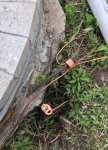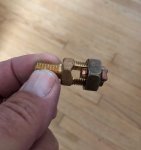We don’t really work on too many pools so I figured you guys would know better than me about them. We are running our conduit from the pool lights back to a central location where we can power them. My only concern is if there is any sort of code that states the pipe has be be a certain distance away from the pool. My thought was to run it along the trench and it will get back filled and covered by the concrete, so the pipe will only be around 12-14” away from the pool. Again, this may be a dumb question but I want to make sure I don’t waste a day and look stupid if we are not abiding by NEC code.
You are using an out of date browser. It may not display this or other websites correctly.
You should upgrade or use an alternative browser.
You should upgrade or use an alternative browser.
Conduit around pool
- Thread starter Dansos
- Start date
- Status
- Not open for further replies.
- Location
- Chapel Hill, NC
- Occupation
- Retired Electrical Contractor
You need to read the following section carefully
680.24 Junction Boxes and Electrical Enclosures for Transformers
or Ground-Fault Circuit Interrupters.
(A) Junction Boxes. A junction box connected to a conduit
that extends directly to a forming shell or mounting bracket of
a no-niche luminaire shall meet the requirements of this
section.
(1) Construction. The junction box shall be listed, labeled,
and identified as a swimming pool junction box and shall
comply with the following conditions:
(1) Be equipped with threaded entries or hubs or a nonmetallic
hub
(2) Be comprised of copper, brass, suitable plastic, or other
approved corrosion-resistant material
(3) Be provided with electrical continuity between every
connected metal conduit and the grounding terminals by
means of copper, brass, or other approved corrosionresistant
metal that is integral with the box
(2) Installation. Where the luminaire operates over the low
voltage contact limit, the junction box location shall comply
with (A)(2)(a) and (A)(2)(b). Where the luminaire operates at
the low voltage contact limit or less, the junction box location
shall be permitted to comply with (A)(2)(c).
(a) Vertical Spacing. The junction box shall be located
not less than 100 mm (4 in.), measured from the inside of the
bottom of the box, above the ground level, or pool deck, or not
less than 200 mm (8 in.) above the maximum pool water level,
whichever provides the greater elevation.
(b) Horizontal Spacing. The junction box shall be located
not less than 1.2 m (4 ft) from the inside wall of the pool,
unless separated from the pool by a solid fence, wall, or other
permanent barrier.
(c) Flush Deck Box. If used on a lighting system operating
at the low voltage contact limit or less, a flush deck box shall be
permitted if both of the following conditions are met:
(1) An approved potting compound is used to fill the box to
prevent the entrance of moisture.
(2) The flush deck box is located not less than 1.2 m (4 ft)
from the inside wall of the pool.
My only concern is if there is any sort of code that states the pipe has be be a certain distance away from the pool.
680.10
- Location
- Tennessee NEC:2017
- Occupation
- Semi-Retired Electrician
Be kind of hard to keep the conduit away from the pool if your running it to the pool lights.
I always run PVC or LFNMC (Car Seal, Seal tight, etc). In the old days, brass conduit was used and that's where all the threaded hubs, conduit entries. etc. come from on the junction boxes.
I either have a trench dug for the lighting conduit or use the plumbing trench if possible.
I hope the OP is installing low voltage lights. They are safe and no bonding required for them.
I always run PVC or LFNMC (Car Seal, Seal tight, etc). In the old days, brass conduit was used and that's where all the threaded hubs, conduit entries. etc. come from on the junction boxes.
I either have a trench dug for the lighting conduit or use the plumbing trench if possible.
I hope the OP is installing low voltage lights. They are safe and no bonding required for them.
thanks for the responses. My piping is running from the wet niche hookup directly to a junction box where the filter and heater will be installed. So as long as THAT junction box is not within 5’ I should be good. The piping going to the wet niche would be considered “pool equipment” and would be allowed to be ran within the 5’ radius of the pool. Does that seem to jive with how the code reads?
- Location
- Tennessee NEC:2017
- Occupation
- Semi-Retired Electrician
No we are installing 120V LED lights. All 3 niches are bonded to the grid. Customer already bought the lights and was not too keen on returning them for low voltage. I have always been a fan of low voltage light as well
Well, if you're running PVC then you will have to run a #8 insulated conductor in with the light cord. It terminates on the lug inside the niche and has to be covered with a potting compound, and then terminates on the grounding bar/terminal in the JB. This is in addition to the bonding required from the outside of niche to the EBG.
Mystic Pools
Senior Member
- Location
- Park Ridge, NJ
- Occupation
- Swimming Pool Contractor
We sometimes set our deck boxes at the pool equipment is it's not too far away and/or if it doesn't exceed the typical 150' cord on the lights.
Otherwise, we'll set them in a spot 10' or more in say a planter area, behind a wall, etc... We'll set the transformer there as well if it's a long run from the power source to avoid using larger wire because of possible voltage drop.
Wet niche lights do require, as stated, a bond wire inside with potting compound as well the back side of the niche.
We have been installing nicheless LED's for about 13 years now. 12V, no bonding or grounding. They're set about 9"-10" below the water as opposed to wet niche at 18"-24" so they're accessible for replacement-no hanging over the pool edge and getting soaked.
Intermatic makes a really nice PVC deck box for 1". Glue directly into box. They also having a mounting bracket which makes for a clean install.
Otherwise, we'll set them in a spot 10' or more in say a planter area, behind a wall, etc... We'll set the transformer there as well if it's a long run from the power source to avoid using larger wire because of possible voltage drop.
Wet niche lights do require, as stated, a bond wire inside with potting compound as well the back side of the niche.
We have been installing nicheless LED's for about 13 years now. 12V, no bonding or grounding. They're set about 9"-10" below the water as opposed to wet niche at 18"-24" so they're accessible for replacement-no hanging over the pool edge and getting soaked.
Intermatic makes a really nice PVC deck box for 1". Glue directly into box. They also having a mounting bracket which makes for a clean install.
Fulthrotl
~Autocorrect is My Worst Enema.~
- Occupation
- E
No we are installing 120V LED lights. All 3 niches are bonded to the grid. Customer already bought the lights and was not too keen on returning them for low voltage. I have always been a fan of low voltage light as well
something i have done to verify the shell is bonded is to take a fluke megger,
and go from the forming shell to the #6 bond around the pool, and megger it
at 1000 volts. the fluke meter will show the voltage applied during the test.
you should end up with 0.0 Mohm resistance, with 1 volt across the connection.
i just bonded my own backyard pool this week, during a remodel. 8' stainless steel
ground rod, and a bunch of #6 copper in the paver sand around the pool. my
pool is old, so it's brass pipe to an above ground j box. i'm running a 120 volt
pentair led light. everything in the backyard is running on dedicated GFI breakers
on a backyard panel next to the pool equipment.

Fulthrotl
~Autocorrect is My Worst Enema.~
- Occupation
- E
- Status
- Not open for further replies.



